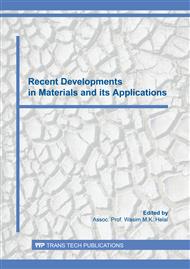[1]
Choy SY, Sun C-N, Leong KF, Wei J. Compressive properties of Ti-6Al-4V lattice structures fabricated by selective laser melting: Design, orientation and density. Additive Manufacturing 2017;16:213-24;.
DOI: 10.1016/j.addma.2017.06.012
Google Scholar
[2]
Tan XP, Tan YJ, Chow CSL, Tor SB, Yeong WY. Metallic powder bed based 3D printing of cellular scaffolds for orthopaedic implants: A state of the art review on manufacturing, topological design, mechanical properties and biocompatibility. Materials Science and Engineering: C 2017;76:1328-43;.
DOI: 10.1016/j.msec.2017.02.094
Google Scholar
[3]
Kadkhodapour J, Montazerian H, Darabi A, Anaraki AP, Ahmadi SM, Zadpoor AA, et al. Failure mechanisms of additively manufactured porous biomaterials: Effects of porosity and type of unit cell. J Mech Behav Biomed Mater 2015;50:180-91;.
DOI: 10.1016/j.jmbbm.2015.06.012
Google Scholar
[4]
Li J, Chen D, Luan H, Zhang Y, Fan Y. Numerical evaluation and prediction of porous implant design and flow performance. Biomed Res Int 2018;2 018:1215021;.
DOI: 10.1155/2018/1215021
Google Scholar
[5]
Pałka K, Pokrowiecki R. Porous titanium implants: A review. Advanced Engineering Materials 2018;20;.
DOI: 10.1002/adem.201700648
Google Scholar
[6]
Gao C, Wang C, Jin H, Wang Z, Li Z, Shi C, et al. Additive manufacturing technique-designed metallic porous implants for clinical application in orthopedics. RSC Advances 2018; 8:25210-27;.
DOI: 10.1039/c8ra04815k
Google Scholar
[7]
Wang X, Xu S, Zhou S, Xu W, Leary M, Choong P, et al. Topological design and additive manufacturing of porous metals for bone scaffolds and orthopaedic implants: A review. Biomaterials 2016;83:127-41;.
DOI: 10.1016/j.biomaterials.2016.01.012
Google Scholar
[8]
Rotta G, Seramak T, Zasińska K. Estimation of young's modulus of the porous titanium alloy with the use of fem package. Advances in Materials Science 2015;15:29-37;.
DOI: 10.1515/adms-2015-0020
Google Scholar
[9]
Horn TJ, Harrysson OLA, Marcellin-Little DJ, West HA, Lascelles BDX, Aman R. Flexural properties of Ti6Al4V rhombic dodecahedron open cellular structures fabricated with electron beam melting. Additive Manufacturing 2014;1-4:2-11;.
DOI: 10.1016/j.addma.2014.05.001
Google Scholar
[10]
Parthasarathy J, Starly B, Raman S, Christensen A. Mechanical evaluation of porous titanium (Ti6Al4V) structures with electron beam melting (EBM). J Mech Behav Biomed Mater 2010;3:249-59;.
DOI: 10.1016/j.jmbbm.2009.10.006
Google Scholar
[11]
Xiao L, Song W, Wang C, Tang H, Fan Q, Liu N, et al. Mechanical properties of open-cell rhombic dodecahedron titanium alloy lattice structure manufactured using electron beam melting under dynamic loading. International Journal of Impact Engineering 2017;100:75-89;.
DOI: 10.1016/j.ijimpeng.2016.10.006
Google Scholar
[12]
Cheng XY, Li SJ, Murr LE, Zhang ZB, Hao YL, Yang R, et al. Compression deformation behavior of Ti6Al4V alloy with cellular structures fabricated by electron beam melting. J Mech Behav Biomed Mater 2012;16:153-62;.
DOI: 10.1016/j.jmbbm.2012.10.005
Google Scholar
[13]
Feng Q, Tang Q, Soe S, Liu Y, Setchi R. An investigation into the quasi-static response of TI6AL4V lattice structures manufactured using selective laser melting. Sustainable Design and Manufacturing2016. pp.399-409;.
DOI: 10.1007/978-3-319-32098-4_34
Google Scholar
[14]
Yan C, Hao L, Hussein A, Young P. Ti6Al4V triply periodic minimal surface structures for bone implants fabricated via selective laser melting. J Mech Behav Biomed Mater 2015; 51:61-73;.
DOI: 10.1016/j.jmbbm.2015.06.024
Google Scholar
[15]
Wang Y, Arabnejad S, Tanzer M, Pasini D. Hip implant design with three dimensional porous architecture of optimized graded density. Journal of Mechanical Design 2018;140;.
DOI: 10.1115/1.4041208
Google Scholar
[16]
Eldesouky I, Harrysson O, West H, Elhofy H. Electron beam melted scaffolds for orthopedic applications. Additive Manufacturing 2017;17:169-75;.
DOI: 10.1016/j.addma.2017.08.005
Google Scholar
[17]
Lai Y-S, Chen W-C, Huang C-H, Cheng C-K, Chan K-K, Chang T-K. The effect of graft strength on knee laxity and graft in-situ forces after posterior cruciate ligament reconstruction. PLOS ONE 2015;10:11;.
DOI: 10.1371/journal.pone.0127293
Google Scholar
[18]
Fouda N, Eltlhawy B, El-Midany T. The effect of using PLA-HA coating on uncemented tibia prosthesis to decrease aseptic loosening and stress shielding. International Journal of Mechanical & Mechatronics Engineering IJMME 2015;15:76-83; ISSN: 22272771.
Google Scholar
[19]
Fouda N, Eltlhawy B, Elmidany T. A three dimensional finite element study for new different knee designs. Trends in Biomaterials Artificial Organs 2017;31:9-15; ISSN: 0971-1198.
Google Scholar
[20]
Completo A, Fonseca F, Simoes JA. Strain shielding in proximal tibia of stemmed knee prosthesis: experimental study. Journal of Biomechanics 2008; 41: 560-6;.
DOI: 10.1016/j.jbiomech.2007.10.006
Google Scholar
[21]
Satya NG, Lewis. Influences of the temporal nature of the applied load and the tibial baseplate material on the stress distribution in a three-dimensional model of the human knee joint containing a prosthetic replacement. Bio-Medical Materials and Engineering 2004; 14:14; ISSN: 09592989.
Google Scholar
[22]
Eldesouky I, Harrysson O, Marcellin-Little DJ, West H, El-Hofy H. Pre-clinical evaluation of the mechanical properties of a low stiffness cement injectable hip stem. Journal of Medical Engineering & Technology 2017;41:681-91;.
DOI: 10.1080/03091902.2017.1394391
Google Scholar
[23]
Mangado N, Quevedo C, Lozano L, Suso S, Cerrolaza M. To what extent the combination of stem length and stem inclination do affect the performance of the tibial component in knee implants? Biomedical Engineering: Applications, Basis and Communications 2015;27;.
DOI: 10.4015/s1016237215500180
Google Scholar


